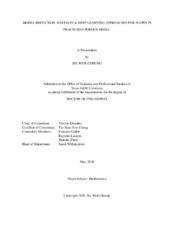| dc.description.abstract | Numerical modelling of flow problems in fractured porous media has important applications in many engineering areas, such as unconventional reservoir simulation and nuclear waste disposal. Simulation of the flow problems in porous media is challenging as numerical discretization results in a very fine mesh for capturing the finest scales and high contrast of the physical properties. On the other hand, the effects of fractures are often modelled by multi-continuum models, resulting coupled systems of equations describing the interactive flow of different continua in heterogenous porous media. While multi-continuum models are widely adopted by different applications, for instance, naturally fractured porous media is modelled by dual porosity approach, shale gas production is modelled by the interactive flow of organic matter, inorganic matter and multiscale fractures in a heterogeneous media, and vuggy carbonate reservoir simulation is characterized by the complex interaction between matrix, fractures and vugs, numerical solutions on the fine grid are often prohibitively expensive in these complex multiscale problems. Extensive research effort had been devoted to developing efficient methods for solving multiscale problems at reduced expense, for example, numerical homogenization approaches and multiscale methods, including Multiscale Finite Element Methods, Variational Multiscale Methods, Heterogeneous Multiscale Methods. The common goal of these methods is to construct numerical solvers on the coarse grid, which is typically much coarser than the fine grid which captures all the heterogeneities in the medium properties. In numerical homogenization approaches, effective properties are computed and the global problem is formulated and solved on the coarse grid. However, these approaches are limited to the cases when the medium properties possess scale separation. In this dissertation, we discuss and analyze novel multiscale model reduction techniques with different model problems arising from flows in porous media and numerical discretization techniques, which can be used for obtaining accurate coarse-scale approximations, even in the case of absence of scale separation. On the other end, Bayesian approaches have been developed for forward and inverse problems to address the uncertainties associated with the solution and the variations of the field parameters, and neural networks approaches are proposed for prediction of flow problems. In the dissertation, we also present methodologies of combining model reduction approaches with Bayesian approaches and deep learning approaches for efficient solution sampling and prediction for flow problems in porous media. | en |


